#justice for Woodrow!!
Text

#woodrow burns#justice for Woodrow!!#I love his character#would love to see flashback of Woodrow with baby nephews and niece#uncle woodrow#rescue humans meme#Xmas related
26 notes
·
View notes
Text



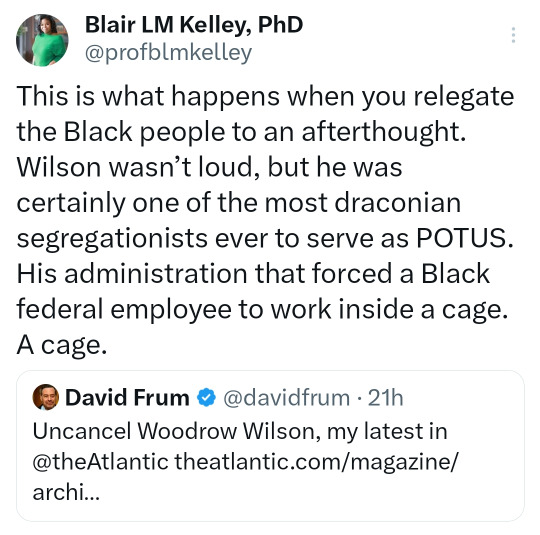

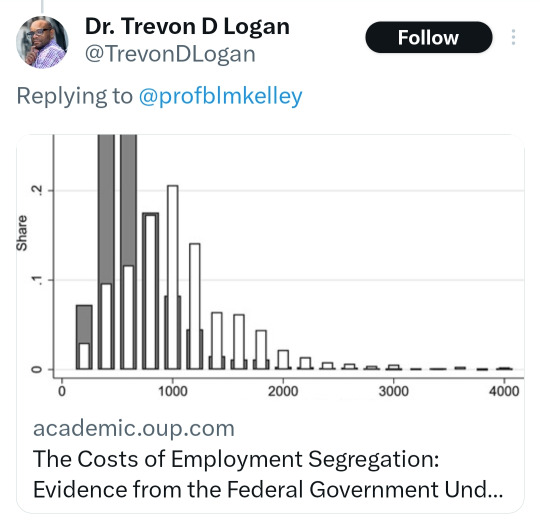
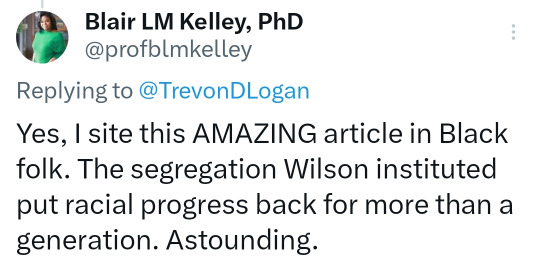

woodrow wilson was a racist cunt.
#Woodrow Wilson#history#white supremacy#racism#social justice#equality#end hate#anti-racism#racial equality#stop racism#no to hate#dismantle racism
231 notes
·
View notes
Text
What Marwan Bishara thinks an honest Herzog would say to Congress today:
I am honoured to speak to you today at the 75th anniversary of my country’s independence. It is an honour that neither I nor my country deserves.
Throughout our history, your steadfast and generous support has made Israel what it is today. President Woodrow Wilson supported the 1917 Balfour Declaration at the behest of the British Empire, committing to our future Jewish state – a commitment made by those who did not own the land to those who did not live on the land, against the will of those who did live on it.
And it was President Harry Truman who first supported the 1947 United Nations Partition Plan to carve that land into a Jewish and Palestinian state, and the first to recognise Israel only 11 minutes after its establishment in 1948. Since then, we have been telling each other how our nations were founded by persecuted migrant communities on the basis of European Enlightenment; how they created strong, vibrant modern states, civilising the savage, and how we have dominated global and Middle East affairs.
We tell each other a tale of how they founded two righteous, God-fearing models to emulate, like “shining beacon of hope” and “light unto the nations”; of sharing common liberal, democratic principles, and of our persistent pursuit of peace.
But if we are honest with ourselves, we should admit that we have also copied the worst of imperial Europe. We share a dark past of settler colonialism, war, ethnic cleansing of Indigenous inhabitants and a persistent history of racism and discrimination including slavery in the Americas, and apartheid in Palestine.
Our success was made possible through the blood and tears of countless victims. We’ve treated our nemeses as warmongers, our critics as enemies, and our enemies as modern-day Hitlers, but no other states have waged as many wars, or embarked on as many military interventions in the past eight decades as we have.
These similarities between our two nations continue to cast a long shadow over our bonds and behaviour.
Since our birth, Israel has had no better ally than the United States. Period. Even though, we have not always been gracious or reciprocated – while generally following in your footsteps, befriending your friends and denouncing your foes.
Whenever the world ganged up on our “Jewish state”, America came to the rescue. When Soviet bloc nations joined Muslim and other developing nations to condemn us for our bellicosity, it was the US that defended us and placated our foes with vigour and zeal. And when Europe joined the international outrage, the US was the only major power ready and able to stand by Israel and block international censures by vetoing consequential UN Security Council resolutions condemning Israel.
Indeed, with the exception of that one “mistake” under Jimmy Carter, when Washington voted against Israeli settlement expansion, the US has routinely vetoed efforts to condemn Israel at the United Nations Security Council, blocking more than 40 such resolutions.
And this week, when a US Congresswoman – one of your own – called Israel racist, you, dear members of Congress, quickly shut her down by proclaiming in a resolution that Israel is not racist. Though I might have put it differently, she was essentially right, you are wrong.
Thanks to you, we have become more confident and assertive. With your military and economic aid that reached some $200bn, we have built a formidable military machine, that allowed us to double down on the repression of the Palestinians, and humiliation of the stubborn Arabs, who refuse to accept our pretence that our culture is superior to theirs, and that our settlement of their land is ours by right of a brief sojourn here a few thousand years ago.
When my late beloved father Chaim spoke to you as president of Israel in 1987, he boasted of our peace accords with Sadat of Egypt. And I am inclined to walk in his shoes and do the same; to boast of our Abraham accords with several Arab autocrats.
But unlike him, I can no longer keep silent as our military and civilian occupation mutates into an apartheid system in the Middle East. I do not say that lightly; I say it with a heavy heart. I do not say it out of pity for the millions of Palestinians, most of whom stubbornly linger under occupation and in refugee camps, I say it out of pity for my people and what’s become of us as decades-long occupiers and dispossessors. Our chutzpah is self-defeating. Our hasbara is wearing thin.
I never was a particularly brave or charismatic parliamentarian and head of the opposition. But that stops now, knowing I will never again have a better platform to address your people and mine. We may have become rich and powerful but we’ve never been so divided, so fanatical; so morally bankrupt.
Friends speak truth to each other. Good friends speak the bitter truth. It befalls upon you, once again, to save us from ourselves. To free us and the Palestinians from an entrenching system of apartheid that is bound to lock us in hatred and violence for decades to come. There is little I can do, as a ceremonial president, other than to speak out.
So, I urge you to condemn racism and apartheid today, as you condemned apartheid in South Africa, albeit belatedly in the past. And I urge you to push us to come to terms with the Palestinians, who soon will become the majority between the Jordan River and the Mediterranean Sea.
Do not believe a word Prime Minister Benjamin Netanyahu says about the Palestinians; he has made a career out of trafficking in fear.
Like my two predecessors, I also believe we have a peace partner in President Mahmoud Abbas; perhaps the last peace partner. We must stop undermining him, as we will never be as lucky with a strong yet accommodating leader.
My father boasted of our liberal democracy and respect for human rights, albeit for Jews only, considering that in our Jewish state, the right to the land, the right to settle (return), and the right to self-determination is for the Jewish collective.
But even this communitarianism has eroded with time, culminating in a government of hyper-nationalists and religious fanatics that is demonstrably bent on destroying our Jewish democracy and squashing our liberal values.
Hundreds of thousands of my fellow Jewish countrymen and women have taken to the streets every week to protest against new illiberal legislation that is bound to chip away at our institutions and freedoms, and destroy any hope of future peace and democracy in the Jewish state.
This destruction will happen if you, members of this august symbol of constitutional democracy, continue to outbid yourselves in appeasing us as we stumble towards religious autocracy. Your intentions to invite our lying, cheating prime minister to speak here for a record fourth time will only make things worse.
President Biden is right to be concerned and to warn our government of going down this road. So should you. It is a dangerous road that is bound to destroy the fabric of our society.
I urge you to be brave and principled, for a change. It is liberating, as I have discovered.
#us congress#werner herzog#israeli invasion#israeli extremism#israeli apartheid#palestine#palestinians#israeli occupation#illegal settlements#justice#free palestine#usa#balfour declaration#woodrow wilson#harry truman#democracy#autocracy#benjamin netanyahu#partition#jimmy carter
12 notes
·
View notes
Text
For now I am sleepy but soon it's my weekend and I can draw as many silly pumperkins as I want maybe some funsize too
#want to draw more palette prime citizens fascinated by those silly guys#hinky just. stealing everything bro stop#fork just so obsessed with his pitchfork and everyone being so catty#talking about how his pitchfork actually sucks#there is no real justice system woodrow just makes them write an apology poem which is so silly in a good way#to me i love it dearly. i also love palette prime in general#the items from woodrows backstory still being littered around everywhere#does the moon still shine at night or does it judt sit there#was it the only moon. what does the night sky look like there. is it a little easier to see even more stars#because the light bpuncing off the moon doesnt get in your eyes#the boar being right behind woodrows house is so unbelievably cruel of the developers why you gotta do that to him#boat not boar lol bye
1 note
·
View note
Text
Jim Justice
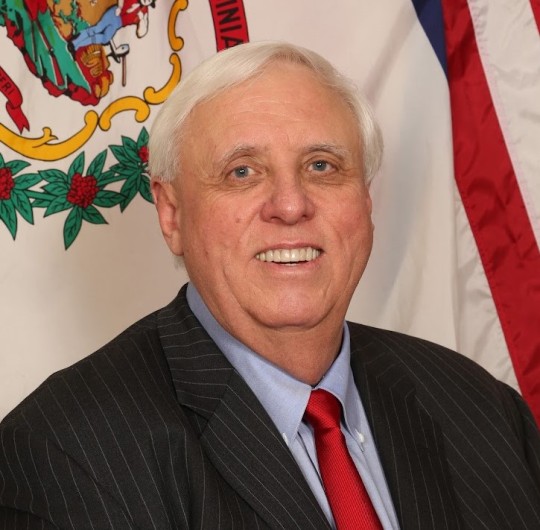
Physique: Heavyset Build
Height: 6’ 7" (2.01 m)
James Conley Justice II (born April 27, 1951-) is an American businessman and politician who has served as the 36th governor of West Virginia since 2017. Justice was once a billionaire, but his net worth had declined to $513.3 million as of 2021. He inherited a coal mining business from his father and built a business empire with 94 companies, including the Greenbrier, a luxury resort in White Sulphur Springs.

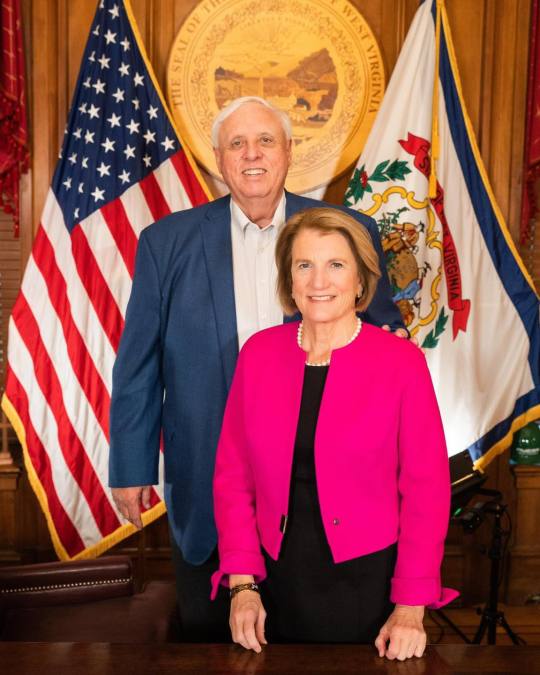


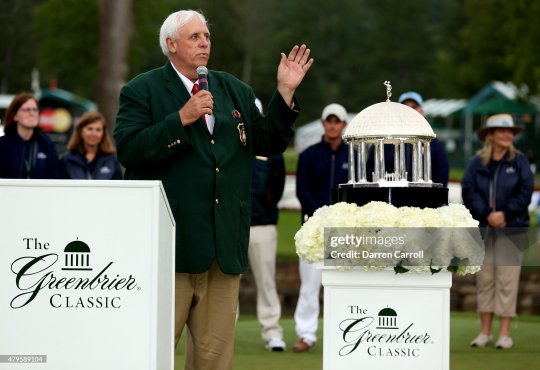
Justice is a well-liked and wealthy coal magnate who is one big fucking bear of a man. No other way to describe him. Hell… he compared himself to a grizzly bear. A 6-foot-7, 400+ pound millionaire grizzly bear. I’ll admit, I’m a little intimidated by the sheer size of him. But once I leave my goo on him, that’ll pass.
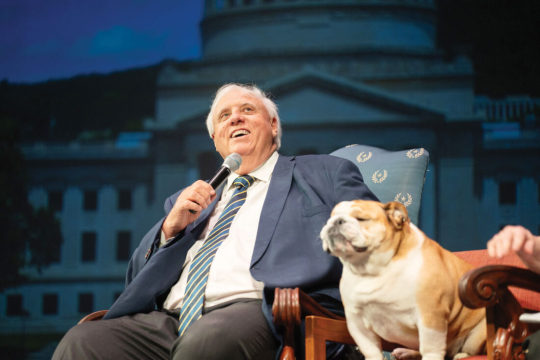
A lifelong West Virginian, he attended Raleigh County public schools and graduated from Woodrow Wilson High School in 1969, and attended Greenbrier Military Academy as a post-graduate. Governor Justice went on to Marshall University in Huntington, West Virginia, and was captain of the golf team for two years before earning his undergraduate degree and a Masters in Business Administration.





Justice married his high school sweetheart, having two adult children and spend time spoiling four grandchildren. In addition, they have three dogs: two Boston Terriers, and their famous Babydog, an English Bulldog. Plus, he coach girls' basketball. Not the most handsomest guy, but I'd love to fuck around with him for a weekend. And for some reason with his dog, Babydog watching.

26 notes
·
View notes
Text
GROVER CLEVELAND
•Grover Cleveland: A Study In Courage by Allan Nevins (BOOK)
•An Honest President: The Life and Presidencies of Grover Cleveland by H. Paul Jeffers (BOOK | AUDIO)
•A Secret Life: The Lies and Scandals of President Grover Cleveland by Charles Lachman (BOOK | KINDLE | AUDIO)
•A Man of Iron: The Turbulent Life and Improbable Presidency of Grover Cleveland by Troy Senik (BOOK | KINDLE | AUDIO)
BENJAMIN HARRISON
•Benjamin Harrison: Hoosier Warrior, 1833-1865 by Harry J. Sievers (BOOK)
•Benjamin Harrison: Hoosier Statesman, 1865-1888 by Harry J. Sievers (BOOK)
•Benjamin Harrison: Hoosier President, 1889-1893 by Harry J. Sievers (BOOK)
WILLIAM McKINLEY
•In the Days of McKinley by Margaret Leech (BOOK)
•President McKinley: Architect of the American Century by Robert W. Merry (BOOK | KINDLE)
•William McKinley and His America by H. Wayne Morgan (BOOK | KINDLE)
•The Triumph of William McKinley: Why the Election of 1896 Still Matters by Karl Rove (BOOK | KINDLE | AUDIO)
THEODORE ROOSEVELT
•The Rise of Theodore Roosevelt by Edmund Morris (BOOK | KINDLE | AUDIO)
•Theodore Rex by Edmund Morris (BOOK | KINDLE | AUDIO)
•Colonel Roosevelt by Edmund Morris (BOOK | KINDLE | AUDIO)
•Edmund Morris Trilogy
•The River of Doubt: Theodore Roosevelt's Darkest Journey by Candice Millard (BOOK | KINDLE | AUDIO)
•Mornings On Horseback: The Story of an Extraordinary Family, a Vanished Way of Life, and the Unique Child Who Became Theodore Roosevelt by David McCullough (BOOK | KINDLE | AUDIO)
•T.R.: The Last Romantic by H.W. Brands (BOOK | KINDLE | AUDIO)
WILLIAM HOWARD TAFT
•The Bully Pulpit: Theodore Roosevelt, William Howard Taft, and the Golden Age of Journalism by Doris Kearns Goodwin (BOOK | KINDLE | AUDIO)
•William Howard Taft: An Intimate History by Judith Icke Anderson (BOOK)
•Chief Executive to Chief Justice: Taft Betwixt the White House and Supreme Court by Lewis L. Gould (BOOK | KINDLE)
WOODROW WILSON
•Wilson by A. Scott Berg (BOOK | KINDLE | AUDIO)
•Woodrow Wilson: A Biography by John Milton Cooper Jr. (BOOK | KINDLE | AUDIO)
•When the Cheering Stopped: The Last Years of Woodrow Wilson by Gene Smith (BOOK | KINDLE)
•The Ordeal of Woodrow Wilson by Herbert Hoover (BOOK)
•The Moralist: Woodrow Wilson and the World He Made by Patricia O'Toole (BOOK | KINDLE | AUDIO)
WARREN G. HARDING
•The Shadow of Blooming Grove: Warren G. Harding in His Times by Francis Russell (BOOK)
•The Available Man: The Life Behind the Masks of Warren G. Harding by Andrew Sinclair (BOOK)
•1920: The Year of the Six Presidents by David Pietrusza (BOOK | KINDLE | AUDIO)
•The Ohio Gang: The World of Warren G. Harding by Charles L. Mee Jr. (BOOK | KINDLE)
CALVIN COOLIDGE
•Coolidge by Amity Shlaes (BOOK | KINDLE | AUDIO)
•The High Tide of American Conservatism: Davis, Coolidge, and the 1924 Election by Garland S. Tucker III (BOOK | KINDLE)
#Books#Book Suggestions#Book Recommendations#Books About Presidents#Presidents#Presidency#Presidents Books#Presidential Books#Grover Cleveland#President Cleveland#Cleveland Administration#Benjamin Harrison#President Harrison#Harrison Administration#William McKinley#President McKinley#McKinley Administration#Assassination of William McKinley#McKinley Assassination#Theodore Roosevelt#President Roosevelt#Roosevelt Administration#TR#William Howard Taft#President Taft#Taft Administration#Woodrow Wilson#President Wilson#Wilson Administration#Warren G. Harding
33 notes
·
View notes
Text
The court of appeal has quashed the prison sentence of a heavily pregnant woman so that she can give birth safely, in a case hailed as a landmark by campaigners.
The woman, 22, is almost eight months pregnant and has been diagnosed with potentially life threatening pre-eclampsia, which affects the mother’s blood vessels and the baby’s blood supply.
The woman was sentenced to five years for possession of a firearm and ammunition, and was serving two and a half years in prison. She did not discover she was pregnant until she was given a routine pregnancy test on arrival in prison.
Campaigners have previously argued that no pregnant women should be housed in the prison estate. In September 2019, a newborn baby, Aisha Cleary, was found dead in a prison cell in HMP Bronzefield after her mother, Rianna, gave birth alone. According to government data, in 2022-23 there were 44 births by women in custody, 98% of them in hospital.
Pippa Woodrow, counsel for the pregnant woman, told a court of appeal hearing on Thursday that the risk of the woman going into premature labour was “live”, and that the management of her pregnancy in prison “does not even seem to meet the requirements of her condition”.
She added that the woman had “a significant history of trauma and mental ill health” and that she was “immature and vulnerable”.
In relation to her crime, Woodrow said: “She has no ongoing association with the negative peers who got her into this mess.”
In an oral ruling, Lord Justice Holroyde, the vice-president of the court of appeal criminal division, along with Mr Justice Garnham and Mr Justice Andrew Baker, said: “We regard this as a quite exceptional case.”
The judges quashed the sentence she had received from a criminal court and replaced it with a two-year suspended sentence with a rehabilitation requirement.
Addressing the woman, who listened tearfully to the judges’ ruling via a video link inside prison, Holroyde said: “This is quite an exceptional course the court is taking. We are doing it because of the exceptional features of your case.”
The woman’s mother, who was in court for the ruling, said afterwards: “I have got my daughter back. Thank you so much. She’s a good girl but she got caught up with the wrong person. Now she can give birth in hospital with me by her side and we can raise this baby together.”
The mother feared her daughter may suffer a similar fate to Rianna Cleary if she gave birth while in prison. She contacted Level Up, which campaigns for an end to the imprisonment of pregnant women, and provided her with help and support.
Janey Starling, a co-director of Level Up, said: “This landmark judgment marks a sea change in sentencing practices. Several other countries do not imprison pregnant women or new mothers and England’s courts are beginning to catch up. Prison will never be a safe place to be pregnant.
“The prison ombudsman, Ministry of Justice and NHS have declared all pregnancies in prison as high risk. This means that when a judge sentences a pregnant woman to prison, they are sentencing her to a high-risk pregnancy. That is unconscionable.”
A Ministry of Justice spokesperson said: “Custody is always the last resort for women, and independent judges consider mitigating factors, like pregnancy, when making sentencing decisions.
“We have made meaningful progress in improving the care available for pregnant women in jail, such as employing specialist mother-and-baby liaison officers in every female prison, and enhancing welfare checks and social services support.”
20 notes
·
View notes
Text
"So each year, hoping he will return, we set an extra place at dinner...for Superman!"
In 1984, the 400th issue of SUPERMAN presented an oversize issue with a series of vignettes about Superman's future, illustrated by a selection of different artists (including Frank Miller and Jim Steranko, among others) and interspersed with pinups and little essays by artists ranging from Will Eisner to Moebius.
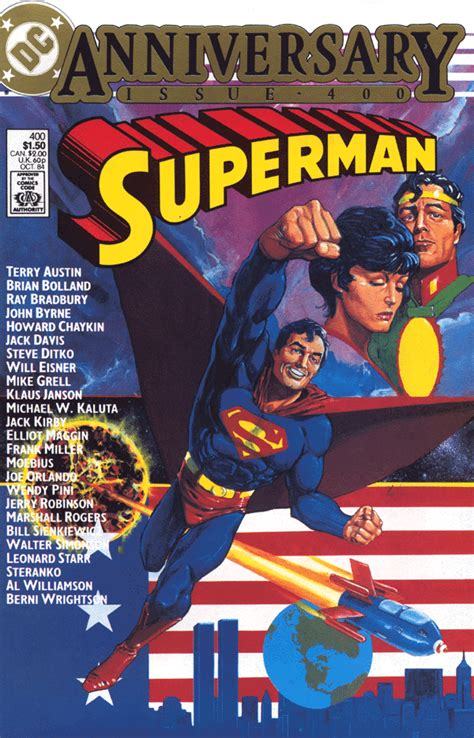
The story itself, mostly written by Elliot S! Maggin, is unusual, since unlike most "Imaginary Stories," it's not interested with Superman's future (whom he marries, whether he has children, etc.), but rather with his eventual transformation into a mythic figure.
The most interesting of the vignettes is this one, drawn and colored by Klaus Janson. The narrative captions aren't always very legible, so I'll transcribe them after each page.
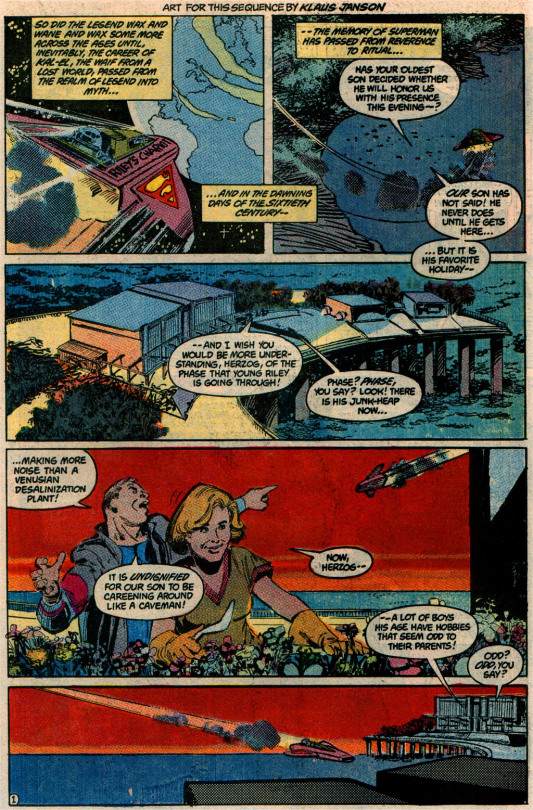
"So did the legend wax and wane and wax some more across the ages until, inevitably, the career of Kal-El, the waif from a lost world, passed from the realm of legend into myth… And in the dawning days of the Sixtieth Century--the memory of Superman has passed from reverence to ritual…"

"Meet Riley Benedix-- Even to 20th-Century eyes Riley's mode of dress would appear eccentric… Worry not--there is an explanation. The hat, of course, is the stovepipe of Abraham Lincoln, who lived soon enough before the great age of heroes to be included among them… The eyes wear the distinctive spectacles of Woodrow Wilson, who made the world safe for democracy… The shirt is that of Superman, greatest of all heroes, who fought for truth, justice, and the American way… Over Riley's back is an Eisenhower jacket, reminiscent of the hero of D-Day… On his feet are the highwater boots of Kuhan Pei-Jing, who slogged through the ricefields of Asian negotiating to head off a Third World War in the 1990's."

"Every year Riley and thousands of other history buffs fly hopelessly outdated spacecraft to Arcturus…to the convention of the 'League of Supermen'--for costume parades, sales of ancient memorabilia, parties, and a bit of unabashed fun… Riley's father never understood fun…"
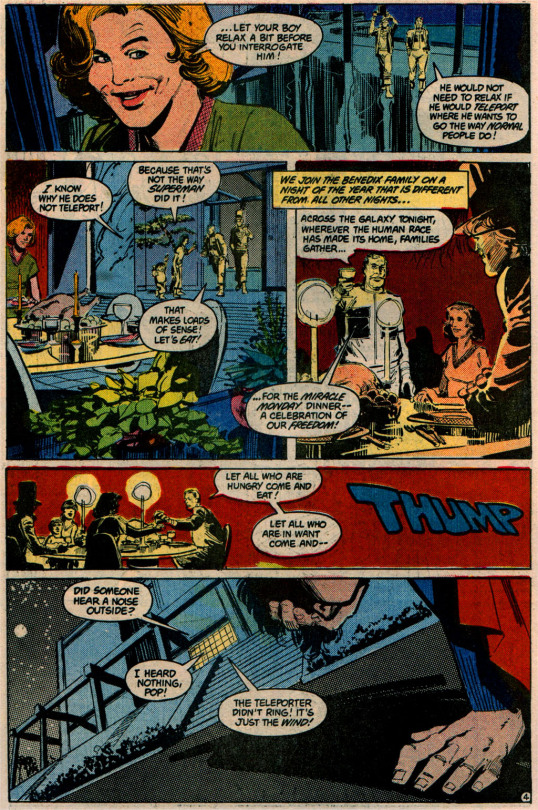
"We join the Benedix family on a night of the year that is different from all other nights…"
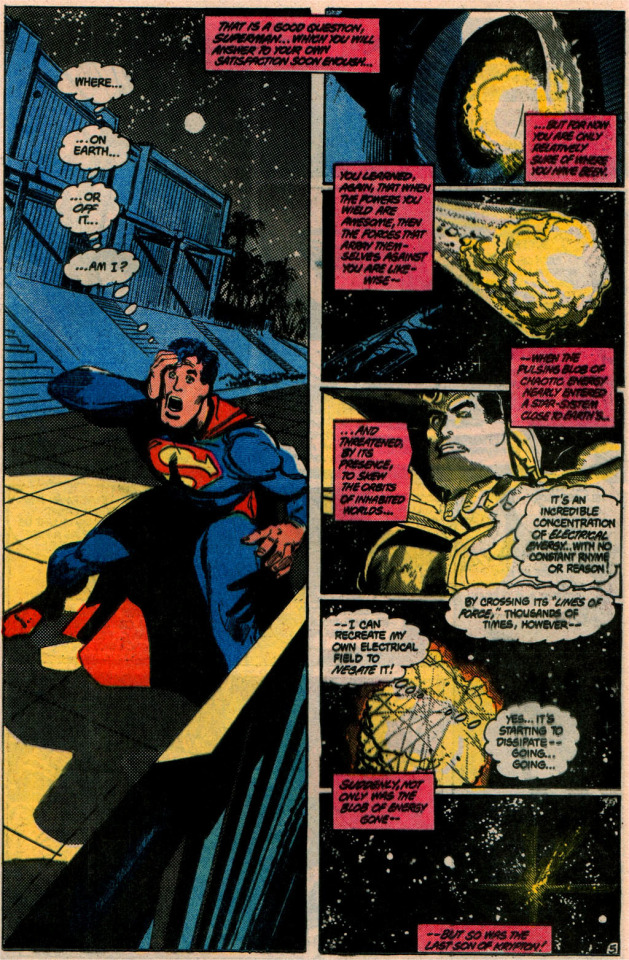
"That is a good question, Superman…which you will answer to your own satisfaction soon enough…but for now you are only relatively sure of where you have been. You learned, again, that when the powers you wield are awesome, then the forces that array themselves against you are likewise--when the pulsing blob of chaotic energy nearly entered a star-system close to Earth's…and threatened, but its presence, to skew the orbits of inhabited worlds… Suddenly, not only was the blob of energy gone--but so was the last son of Krypton!"
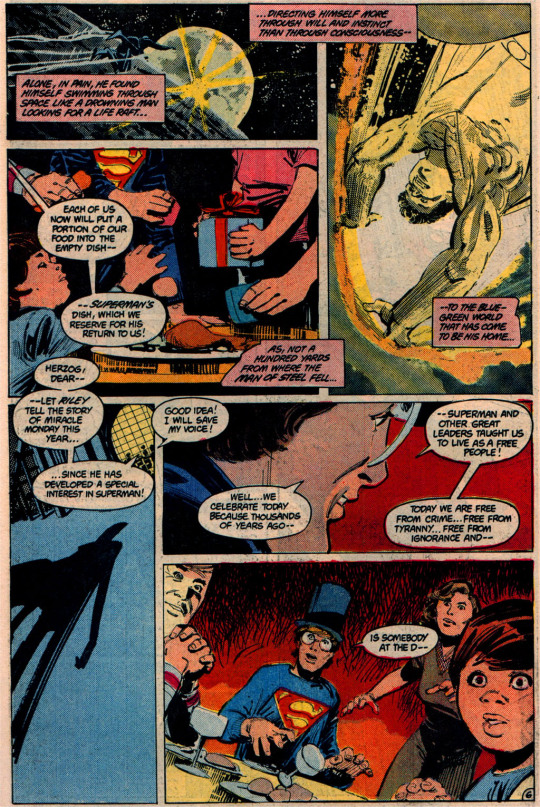
"Alone, in pain, he found himself swimming through space like a drowning man looking for a life raft…directing himself more through will and instinct than through consciousness--to the blue-green world that has come to be his home. As, not a hundred yards from where the Man of Steel fell…"
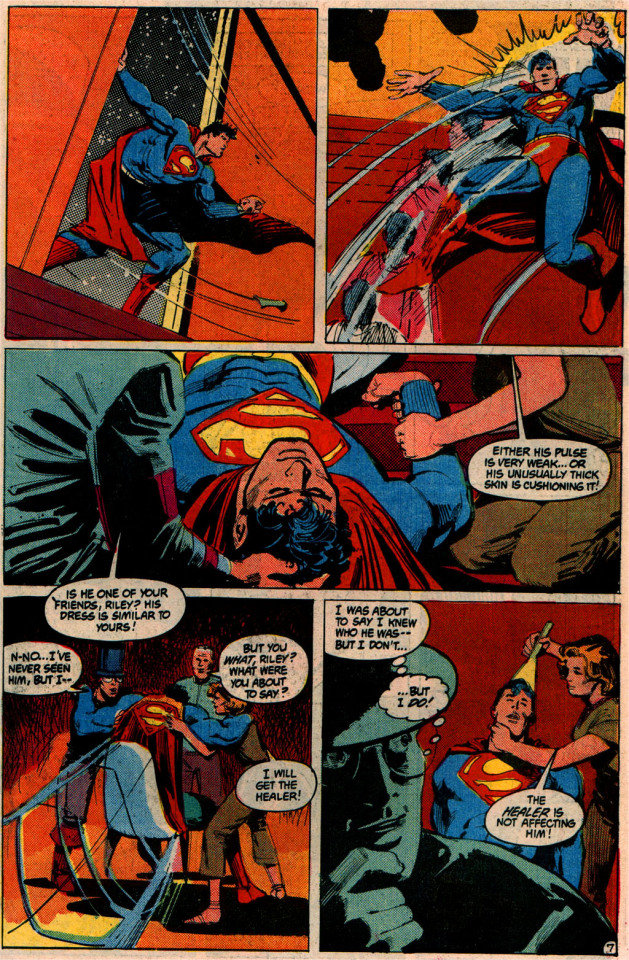

"Soon, the stranger opens his eyes, looks around, and wonders…"

"So young Riley Benedix does continue the story of this festive day for his family…and he is the only one who knows that one of the story's main characters is here at the table with them all! It is a story of the days when America was young…and a child who could change the course of mighty rivers came to Earth--to exemplify all that American had and would come to stand for! Some of the story is accurate…some is clouded by the folds of myth and time--but like art and greatness, it is all true!"
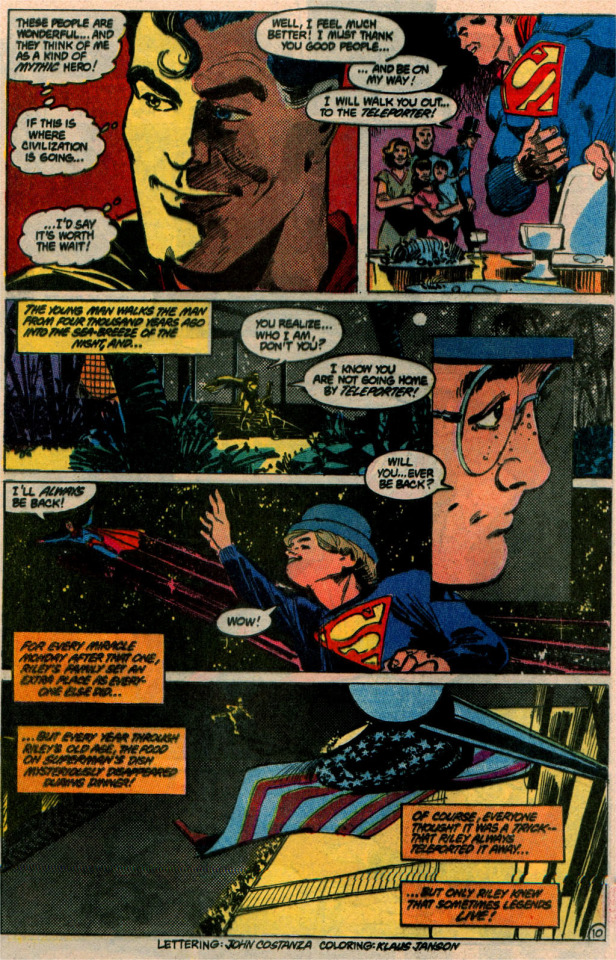
"The young man walks the man from four thousand years ago into the sea-breeze of the night, and… For every Miracle Monday after that one, Riley's family set an extra place as everyone else did…but every year through Riley's old age, the food on Superman's dish mysteriously disappeared during dinner! Of course, everyone thought it was a trick--that Riley always teleported it away…but only Riley knew that sometimes legends live!"
Miracle Monday is a recurring holiday in Maggin's Superman stories, celebrated the third Monday of each May. It's explained in Maggin's 1981 prose novel of the same name, in which Superman beats the Devil (in the form of one C.W. Saturn) with some assistance from a time-traveling 29th century historian named Kristen Wells and an unexpected last-minute save from Lex Luthor (who was a very different character in that era and whom Maggin generally presented in a relatively sympathetic light).
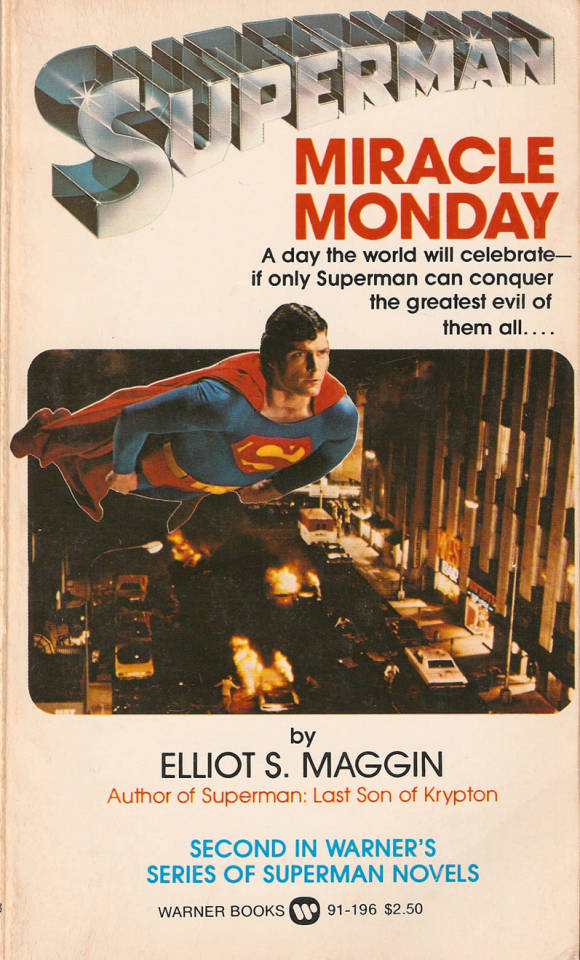
(The cover of the novel tends to imply that it's a novelization of the Christopher Reeve SUPERMAN 2, which it's not, despite the glossy center section with photos from that movie.)
Maggin, who was a regular writer of the Superman comics in the '70s and '80s, later returned Kristen Wells in DC COMICS PRESENTS Annual #2 (1983) and #4 (1985), which make reference to the events of the novel.
In any event, the Benedix family's Miracle Monday celebration is very plainly modeled on a Passover seder, with an empty plate for Superman taking the place of the extra glass of wine poured for the prophet Elijah. It doesn't appear they've left the door open for Superman, but his appearance at the open door is obviously intended to evoke that tradition.
There is a lot of Jewish-coded content in the Superman stories of the Silver Age and Bronze Age (from 1958 to 1986) — a lot more than in the Golden Age, unless you really strain, and MUCH more than in the period following the John Byrne revamp begun in 1986–1987, which pointedly did away with most of that stuff — and this is a particularly clear example. In that respect, it's notable that the Miracle Monday seder is expressly an Earth custom; much of what you can most readily identify as Jewish-coded in these stories is associated with the Kryptonian diaspora.
Regarding the story's narrative coda, it may be worth pointing out that while this story has Superman initially thrown through time by a mysterious space phenomenon, the "pre-Crisis" Silver Age/Bronze Age Superman could fly at superluminal speeds, and was capable of both interstellar travel and time travel under his own power. There were some complicated (and irregularly applied) rules about traveling to time periods in which he already existed, but Superman was capable of simply traveling forward in time and then returning to his own time more or less whenever he felt like it, which is how he was able to perform this little parlor trick for Riley. That was one of the abilities that John Byrne removed in the wake of MAN OF STEEL, in the effort to reduce Superman's powers and try to tie them to a specific set of pseudo-scientific rules.
42 notes
·
View notes
Text

RIVER BILLINGHAM ( JUSTICE SMITH ) is a TWENTY-EIGHT year-old SCREENWRITER in LOS ANGELES. They were brought under Richard’s care when they were only TWELVE. They are known as THE MELODRAMATIC because they are IDEALISTIC but also TEMPERAMENTAL. Let’s see what choice they make regarding the fate of Woodrow House
BASIC INFORMATION.
Full Name: Christopher River Billingham
Nickname(s): As a child he used to go by Christopher. He decided to start going by his middle name when he moved to Woodrow. River had always preferred his middle name to his first name. Christopher was too inconspicuous and boring. He decided that moving to a new place was the perfect time to reinvent himself (as much as you can reinvent yourself as an twelve year old). Plus, he associated his first name with his parents and didn't want anyone else to call him that.
Date of Birth: March 3rd 1977
Age: 28
Occupation: Screenwriter
Current Residence: Los Angeles, California
PHYSICAL APPEARANCE.
Hair: Right now River has a curly bleach blond close cropped fade. Please always picture Justice in Generation even when I'm using gifs from other projects x
Eyes: Brown
Height: 6ft1
Notable Features: Dimples and a cute wide smile but he won't be smiling very much through the course of this rp
PERSONALITY & BEHAVIOR:
Strengths: Inventive,spontaneous and compassionate
Weaknesses: Immature,credulous and scattered
Quirks: Frequently chews gum, talks with his hands, usually wears multiple bracelets which he plays with,regularly gasps de and used to chew pens tops when he used pens more often
Vices:River is a very pleasure seeking person so has dabbled in alcohol, nicotine and drugs at various points in his life. He was a regular smoker from the ages of 16-19 but he didn't like the lingering smell of cigarettes on his clothes so decided to fill the hole nic left with red bull.
INTEREST & HOBBIES:
Interests: Writing, fashion, the history of film & photography, literature and after he processed his parents deaths he got back into music.
Hobbies: River has cds but he stands by his tape collection. He doesn't go out as much as he used to in his early 20s but he still enjoys clubbing. He also enjoys rollerblading and painting
Special Skills/Talents: Depending on when you ask him River would either answer this question with “Whatever I put my mind to.” or “Nothing.” He's pretty good at writing and acting. He learned to play the drums as a child but stopped after his parents death. However, he started playing the drums again in his late teens. He has tried djing a couple of times and is quite good at that
BECOMING A WARD.
cws: lightly implied period typical racism and this is woodrow ward lore so parental death (this time with a slight twist on a motor accident)
When River was born his dad was the frontman of a popular psychedelic rock band. River’s birth and his parents long term mostly monogamous relationship was kept a secret from the press because it was safer and more beneficial for River's dad to act as a cool sexually available rockstar than admit to the public that the Black woman working as the bands public assistant was actually his wife. Even long after the band split up and River's dad had moved onto making weird but very of the time new wave music as a solo artist he kept River's existence a secret from the general public. This was so River could have an upbringing that was more luxurious than most people's but didn't involve his classmates asking about his dad or being pestered by the paparazzi. River’s upbringing was very sheltered and he still views his childhood as an idyllic time in his life. His primary caretaker was a nanny but at the time he didn't see this as a negative experience and he didn't feel emotionally neglected by his parents. It was an exciting treat every time they stayed with him for long periods of time. When he was twelve both of his parents went on the twentieth anniversary reunion tour for his dad's band's first album. There was a horrific tour bus crash in which both of his parents died. Even though the general public didn't know he existed, various rich people his parents met at charity events did (this includes Richard Woodrow). Forever the bleeding heart Richard offered to take in River. Both sets of River's grandparents agreed that there would be less chance of a scandal and word getting out about River existing if he lived at Richard's secluded New York Estate.
LIFE AS A WARD.
Unsurprisingly, River was very volatile when he first moved to Woodrow House. He was a sensitive pre-teen who was grieving his parents and had just moved to the other side of the country. He would snap at unexpected moments and cry for no particular reason. With the passage of time and the best therapy Richard could buy that behaviour eased up. However, he was still one of the more expressive wards. He would make his emotions known through his words and actions. He was probably a source of great annoyance for most of the wards. But I'm sure at least one of them found him to be fun, charming and loving. River enjoyed having lots of people around Woodrow as a teenager. He's a true extrovert and being around others reinvigorates him. Though growing up River often felt like a failure compared to some of the other wards because he wasn't an academic genius.
AESTHETIC .
River's sense of style is a lot more garish and informal than most of the other wards. He has a behind the scenes job in film and tv and lives in LA so he really can wear whatever he wants. He has a lot of loose fitting brightly coloured shirts. But he's still young and hot enough for the occasional tight tank top. He also has a lot of shorts of various colours and textures. He does not have many clothes that are weather appropriate for New York. River has one of his ears pierced so he often wear stud earrings or little hoops. He loves wearing multiple embroidered bracelets at once
EDUCATION.
River chose to go to the same private school other wards had/were attending. He wanted to prove that he was as good as they were despite not being a natural academic. Another reason River wanted to go to a real school was because he wanted to meet more people and have a social life outside of the other wards. While in school one of the writing exercises River enjoyed the most was screenwriting and he wanted to go back to California so that's why he applied for a BFA in film at Dodge.
EXTRACURRICULARS.
If it wasn't clear River was a very artistic and dramatic adolescent. He spent a lot of time painting and crafting in the art room. He also enjoyed creative writing. When he started private school he did drama and directed multiple productions. River wasn't interested in sports but decided to try to find some he enjoyed because he knew Richard thought sport was an important part of making the wards well rounded individuals. Plus, he was jealous of the cute little outfits other wards wore as sports uniforms. He played cricket for multiple years. He never fully understood the rules but knew he had to run after batting the ball and thought cricket whites looked chic. He also took up dressage because he thought there was something sweet about doing a sport where you need to connect to an animal and again he got to wear a fun outfit.
LIFE NOW.
River has been coasting through life since graduation. He decided to stay in LA to pursue screenwriting and because he's a west coast baby at heart. Two of his scripts have been made into movies but they weren't big Hollywood features. The movies he wrote were very low budget indie dramas that didn't make much money. The biggest fans of his films are probably people who found them at the Dollar Tree DVD basket. River mainly writes TV show episodes. His most steady source of income is a medical drama. His lifestyle hasn't changed much since his early 20s. He goes out to clubs to feel something and make meaningful fleeting connections. The only way he's more successful than most of the other wards is the fact he has a spacious house with a pool. He uses the fact his house was expensive to justify why he has 3 housemates (an actress who mainly works in tv, a mildly famous model and a director he met because she directed one of his scripts). He also has a cat called Saskia. He adopted her from a friend who couldn't look after her anymore after moving in with her boyfriend with cat hair allergies. River brought Saskia to Woodrow House with him because she’s a daddy's girl and would make everyone's lives miserable if he left her for weeks.
7 notes
·
View notes
Text
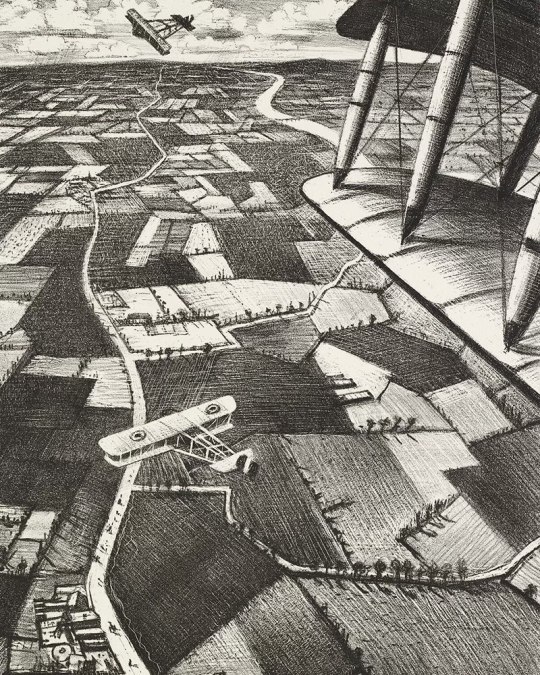
In the Air by Christopher Nevinson, 1917. Lithograph.
Today is Armistice Day, commemorated every year on 11 November to mark the end of the First World War and the armistice signed.
In this work by Christopher Nevinson the abstract patchwork of fields is laid out under the wing of a military aircraft, the sharp angles of the composition emphasising the dizzying height of the plane. During the war, the world was being seen from entirely new angles, inspiring artists to experiment and to depict landscape in new, unexpected ways.
LETTERS FROM AN AMERICAN
November 11, 2023
HEATHER COX RICHARDSON
NOV 12, 2023
In 1918, at the end of four years of World War I’s devastation, leaders negotiated for the guns in Europe to fall silent once and for all on the eleventh hour of the eleventh day of the eleventh month. It was not technically the end of the war, which came with the Treaty of Versailles. Leaders signed that treaty on June 28, 1919, five years to the day after the assassination of Austrian Archduke Franz Ferdinand set off the conflict. But the armistice declared on November 11 held, and Armistice Day became popularly known as the day “The Great War,” which killed at least 40 million people, ended.
In November 1919, President Woodrow Wilson commemorated Armistice Day, saying that Americans would reflect on the anniversary of the armistice “with solemn pride in the heroism of those who died in the country’s service and with gratitude for the victory, both because of the thing from which it has freed us and because of the opportunity it has given America to show her sympathy with peace and justice in the councils of the nations…."
But Wilson was disappointed that the soldiers’ sacrifices had not changed the nation’s approach to international affairs. The Senate, under the leadership of Republican Henry Cabot Lodge of Massachusetts—who had been determined to weaken Wilson as soon as the imperatives of the war had fallen away—refused to permit the United States to join the League of Nations, Wilson’s brainchild: a forum for countries to work out their differences with diplomacy, rather than resorting to bloodshed.
On November 10, 1923, just four years after he had established Armistice Day, former President Wilson spoke to the American people over the new medium of radio, giving the nation’s first live, nationwide broadcast.
“The anniversary of Armistice Day should stir us to a great exaltation of spirit,” he said, as Americans remembered that it was their example that had “by those early days of that never to be forgotten November, lifted the nations of the world to the lofty levels of vision and achievement upon which the great war for democracy and right was fought and won.”
But he lamented “the shameful fact that when victory was won,…chiefly by the indomitable spirit and ungrudging sacrifices of our own incomparable soldiers[,] we turned our backs upon our associates and refused to bear any responsible part in the administration of peace, or the firm and permanent establishment of the results of the war—won at so terrible a cost of life and treasure—and withdrew into a sullen and selfish isolation which is deeply ignoble because manifestly cowardly and dishonorable.”
Wilson said that a return to engagement with international affairs was “inevitable”; the U.S. eventually would have to take up its “true part in the affairs of the world.”
Congress didn’t want to hear it. In 1926 it passed a resolution noting that since November 11, 1918, “marked the cessation of the most destructive, sanguinary, and far reaching war in human annals and the resumption by the people of the United States of peaceful relations with other nations, which we hope may never again be severed,” the anniversary of that date “should be commemorated with thanksgiving and prayer and exercises designed to perpetuate peace through good will and mutual understanding between nations.”
In 1938, Congress made November 11 a legal holiday to be dedicated to world peace.
But neither the “war to end all wars” nor the commemorations of it, ended war.
Just three years after Congress made Armistice Day a holiday for peace, American armed forces were fighting a second world war, even more devastating than the first. The carnage of World War II gave power to the idea of trying to stop wars by establishing a rules-based international order. Rather than trying to push their own boundaries and interests whenever they could gain advantage, countries agreed to abide by a series of rules that promoted peace, economic cooperation, and security.
The new international system provided forums for countries to discuss their differences—like the United Nations, founded in 1945—and mechanisms for them to protect each other, like the North Atlantic Treaty Organization (NATO), established in 1949, which has a mutual defense pact that says any attack on a NATO country will be considered an attack on all of them.
In the years since, those agreements multiplied and were deepened and broadened to include more countries and more ties. While the U.S. and other countries sometimes fail to honor them, their central theory remains important: no country should be able to attack a neighbor, slaughter its people, and steal its lands at will. This concept preserved decades of relative peace compared to the horrors of the early twentieth century, but it is a concept that is currently under attack as autocrats increasingly reject the idea of a rules-based international order and claim the right to act however they wish.
In 1954, to honor the armed forces of wars after World War I, Congress amended the law creating Armistice Day by striking out the word “armistice” and putting “veterans” in its place. President Dwight D. Eisenhower, himself a veteran who had served as the supreme commander of the Allied Expeditionary Force in Europe and who had become a five-star general of the Army before his political career, later issued a proclamation asking Americans to observe Veterans Day:
“[L]et us solemnly remember the sacrifices of all those who fought so valiantly, on the seas, in the air, and on foreign shores, to preserve our heritage of freedom, and let us reconsecrate ourselves to the task of promoting an enduring peace so that their efforts shall not have been in vain.”
—
LETTERS FROM AN AMERICAN
HEATHER COX RICHARDSON
#first world war#armistice#Letters From An American#Heather Cox Richardson#Dwight D. Eisenhower#war#peace#war and peace#soldier#soldiers#veterans#history#WWI#WWII
12 notes
·
View notes
Photo


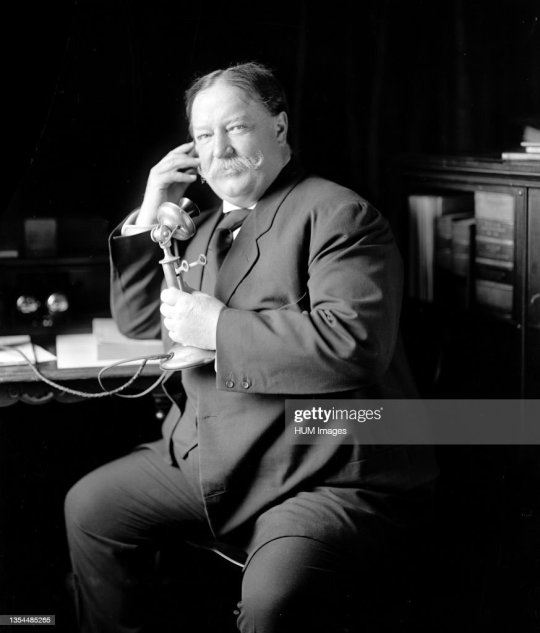


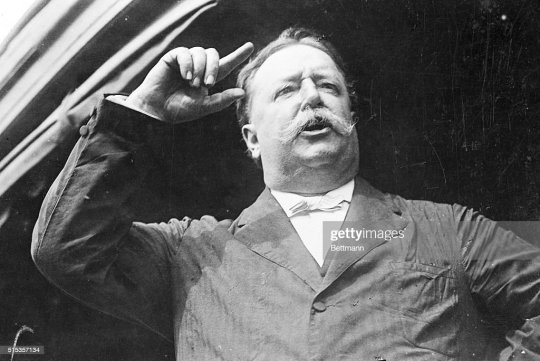

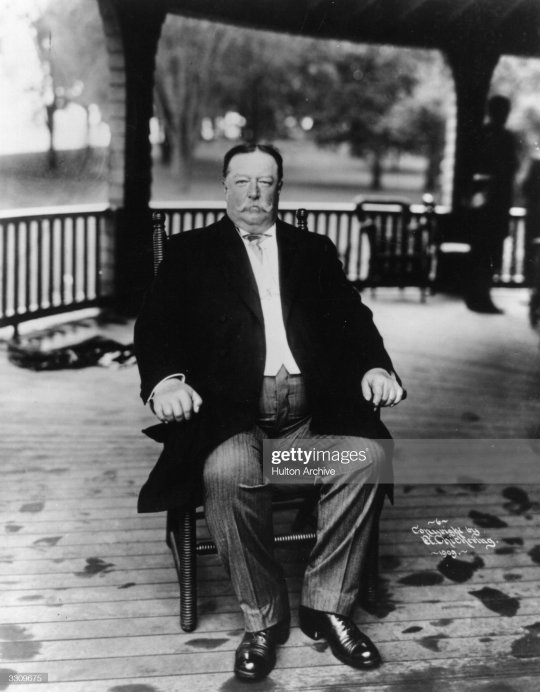
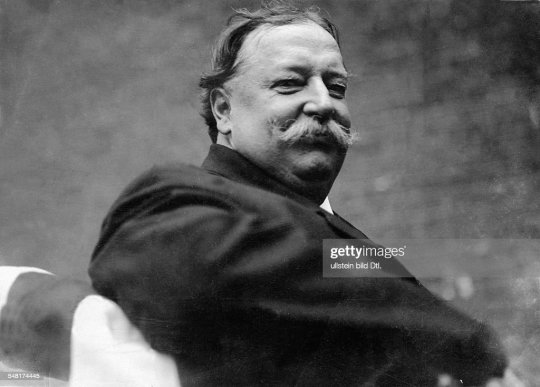
William Taft (1857-1930)
Physique: Average Build
Height: 6′ 0″
William Howard Taft was the 27th president of the United States and the tenth chief justice of the United States, the only person to have held both offices. Taft was elected president in 1908, the chosen successor of Theodore Roosevelt, but was defeated for reelection in 1912 by Woodrow Wilson after Roosevelt split the Republican vote by running as a third-party candidate. In 1921, President Warren G. Harding appointed Taft to be chief justice, a position he held until a month before his death. He was buried at Arlington National Cemetery, the first president and first Supreme Court justice to be interred there.
Taft is generally listed near the middle in historians' rankings of U.S. presidents. But to me, he's top 10 looks whys. Just check out that body. And trust me, I have. I bet he would have been a great bottom.
126 notes
·
View notes
Text
There's so many changes made in Director's Cut that it should be fine to just Make Shit Up about what happens after. They could legit be entirely different continuities at this point. It's not like we ever got a TOD2 remake to match it, after all.
Don't like TOD2's ideas? Clear 'em off the table. Don't like how [insert detail here] was handled? Think it'd be interesting to address the aftermath? Did supplemental material try and fail to do it justice? Do it!!
If Stahn and Rutee weren't working as a romantic couple for you, have them decide their dynamic is better as friends. Or make it a dramatic breakup, I don't care. Did you prefer Philia as his match? Go for it. Someone else? Go for it. Nobody? Go for it. Literally everyone? Go for it.
Want to go deep sea diving to recover Chal right after the game ends? Go for it. Want to explore the morbidity of finding (or not finding) Leon's corpse down there with him? Go for it.
Want Leon to wash up on the beach shore hacking up sea water? WHY NOT? There's not a 0 percent chance that he could have escaped the mine all on his own. What did he do after? Up to you!!
Give Stahn another kid, I don't care. Give him 20. Make him infertile. Make him go back to Lienea and herd sheep until he's as old as his grandpa. Make him travel the world doing what he can to help out with all the fallout from Mictlan's bullshit. Let him see more of humanity's ugliness. Explore whether it breaks him or bolsters him.
Don't want Kyle or even Stahn as the protagonist? Then don't. Follow someone else. Giant political drama with Woodrow and Philia as dual protagonists. Follow someone else and give them a good story.
The possibilities are ENDLESS. SCREW EVERYTHING, WRITE YOUR OWN TALES OF DESTINY DIRECTOR'S CUT 2.
#tales of destiny#frimofa#something this fandom missed out on from being so old was modern fandom's tendency to go buck wild with incomplete material#have you seen how many different ways people think dltarune could go and how many novel length fanfics they've written about it since chp1#we deserve that too
4 notes
·
View notes
Note
I was going to send this ask earlier, but I got sidetracked by life.
I hope you're enjoying my Phandrow playlist as I am! I hope I did your story justice, and I actually wanted to tell you why I chose certain songs for this ship. Now, a good portion is self-explanatory (Phantom of the Opera, Edgar Allan Poe, dramatic love songs via Dracula and the Addams Family), but it's the very first four songs that I believe are truly the embodiment of "Of Curses and Verses".
The Gloom - a ballad of sorts about depression, describing a person who lives in the gloom. This is the introduction to Woodrow AND Phantom, two different characters who find each other within the shadows of their misfortune.
Disappear - a tragic and heartbreaking love song that holds on to whatever spark of hope (ha!) is left. Like The Gloom, Disappear is Phantom and Woodrow spilling their hearts out to each other while hanging out inside the fallen moon in Pallette Prime. They're both very unlucky in life and they reach out to each other, desiring to be understood yet worried about the limited amount of time they have.
The Dark Ones - Now this one is more of an fan interpretation, as this song is a combination of Phantom's quote, "...and damn the consequences", and Woodrow's overwhelming urge to write his poetry shown through creeping nightmares. The Dark Ones tempt our sad boi poet into giving up his creative abstinence and relish in its misfortune. Also, I imagined this as an animatic where the embodiment of unluckiness, in the form of Phantom, seduces Woodrow and thus driving him into madness a la running into the woods. 👉👈
The Dawn - The bittersweet end of the story. Things have been somewhat better, both lovers are still depressed and yet there's a sense of freedom between them. Their love didn't die with the Gloom, and they both live for each other as they comfort each other through their worst times.
I swear, every time I think about "Of Curses and Verses" or Phandrow in general, these two become more and more like a Gothic novel couple.
Oh I totally getcha, "Side-tracked by life" is the story of my... well, my life, lol
But YES, I appreciate all this so much- you really seem to understand the appeal of them as a couple in the same way I do, and what I was trying to do in the fanfic. Rest assured the playlist will serve me as plenty of inspiration in the future, for both drawings and fics :D Because I will be obsessed with them forever even if Phantom comes back in the Rayman DLC and looks directly in the camera and says "By the way, I met Woodrow. Can't stand him." I WILL STILL MAKE IT WORK. I BELIEVE
And by the way, when I get back to Music of the Night, it definitely focuses more on the monstrous/dark temptation aspect... it's a shame I'm going on a trip this weekend because I actually want to write more RIGHT NOW
7 notes
·
View notes
Text
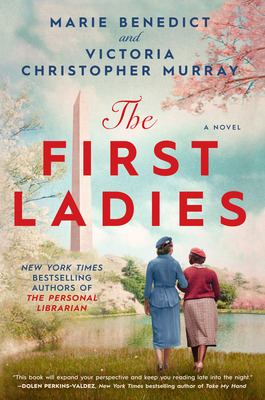
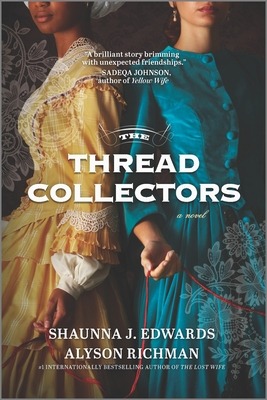


Read-Alike Friday: The First Ladies
The First Ladies by Marie Benedict & Victoria Christopher Murray
The daughter of formerly enslaved parents, Mary McLeod Bethune refuses to back down as white supremacists attempt to thwart her work. She marches on as an activist and an educator, and as her reputation grows she becomes a celebrity, revered by titans of business and recognized by U.S. Presidents. Eleanor Roosevelt herself is awestruck and eager to make her acquaintance. Initially drawn together because of their shared belief in women’s rights and the power of education, Mary and Eleanor become fast friends confiding their secrets, hopes and dreams—and holding each other’s hands through tragedy and triumph.
When Franklin Delano Roosevelt is elected president, the two women begin to collaborate more closely, particularly as Eleanor moves toward her own agenda separate from FDR, a consequence of the devastating discovery of her husband’s secret love affair. Eleanor becomes a controversial First Lady for her outspokenness, particularly on civil rights. And when she receives threats because of her strong ties to Mary, it only fuels the women’s desire to fight together for justice and equality.
This is the story of two different, yet equally formidable, passionate, and committed women, and the way in which their singular friendship helped form the foundation for the modern civil rights movement.
The Thread Collectors by Shaunna J. Edwards & Alyson Richman
1863: In a small Creole cottage in New Orleans, an ingenious young Black woman named Stella embroiders intricate maps on repurposed cloth to help enslaved men flee and join the Union Army. Bound to a man who would kill her if he knew of her clandestine activities, Stella has to hide not only her efforts but her love for William, a Black soldier and a brilliant musician.
Meanwhile, in New York City, a Jewish woman stitches a quilt for her husband, who is stationed in Louisiana with the Union Army. Between abolitionist meetings, Lily rolls bandages and crafts quilts with her sewing circle for other soldiers, too, hoping for their safe return home. But when months go by without word from her husband, Lily resolves to make the perilous journey South to search for him.
As these two women risk everything for love and freedom during the brutal Civil War, their paths converge in New Orleans, where an unexpected encounter leads them to discover that even the most delicate threads have the capacity to save us. Loosely inspired by the authors' family histories, this stunning novel will stay with readers for a long time.
The Women's March by Jennifer Chiaverini
Twenty-five-year-old Alice Paul returns to her native New Jersey after several years on the front lines of the suffrage movement in Great Britain. Weakened from imprisonment and hunger strikes, she is nevertheless determined to invigorate the stagnant suffrage movement in her homeland. Nine states have already granted women voting rights, but only a constitutional amendment will secure the vote for all. To inspire support for the campaign, Alice organizes a magnificent procession down Pennsylvania Avenue in Washington, DC, the day before the inauguration of President-elect Woodrow Wilson, a firm antisuffragist.
Joining the march is thirty-nine-year-old New Yorker Maud Malone, librarian and advocate for women’s and workers’ rights. The daughter of Irish immigrants, Maud has acquired a reputation—and a criminal record—for interrupting politicians’ speeches with pointed questions they’d rather ignore.
Civil rights activist and journalist Ida B. Wells-Barnett resolves that women of color must also be included in the march—and the proposed amendment. Born into slavery in Mississippi, Ida worries that white suffragists may exclude Black women if it serves their own interests. On March 3, 1913, the glorious march commences, but negligent police allow vast crowds of belligerent men to block the parade route—jeering, shouting threats, assaulting the marchers—endangering not only the success of the demonstration but the women’s very lives.
Inspired by actual events, The Women’s March offers a fascinating account of a crucial but little-remembered moment in American history, a turning point in the struggle for women’s rights.
Undiscovered Country by Kelly O'Connor McNees
In 1932, New York City, top reporter Lorena “Hick” Hickok starts each day with a front page byline―and finishes it swigging bourbon and planning her next big scoop.
But an assignment to cover FDR’s campaign―and write a feature on his wife, Eleanor―turns Hick’s hard-won independent life on its ear. Soon her work, and the secret entanglement with the new first lady, will take her from New York and Washington to Scotts Run, West Virginia, where impoverished coal miners’ families wait in fear that the New Deal’s promised hope will pass them by. Together, Eleanor and Hick imagine how the new town of Arthurdale could change the fate of hundreds of lives. But doing what is right does not come cheap, and Hick will pay in ways she never could have imagined.
Undiscovered Country artfully mixes fact and fiction to portray the intense relationship between this unlikely pair. Inspired by the historical record, including the more than three thousand letters Hick and Eleanor exchanged over a span of thirty years, McNees tells this story through Hick’s tough, tender, and unforgettable voice. A remarkable portrait of Depression-era America, this novel tells the poignant story of how a love that was forced to remain hidden nevertheless changed history.
#historical fiction#fiction#library books#readalikes#reading recommendations#reading recs#book recommendations#book recs#to read#tbr#tbrpile#booklr#book tumblr#book blog#library blog
7 notes
·
View notes
Text
For Women’s History Month an article about the National American Woman Suffrage Association procession that includes the different women who marched.

"Miles of Fluttering Femininity Present Entrancing Suffrage Appeal"
Washington Post
On March 3, 1913, the day before Woodrow Wilson's presidential inauguration, thousands of women marched along Pennsylvania Avenue--the same route that the inaugural parade would take the next day--in a procession organized by the National American Woman Suffrage Association (NAWSA). Designed to illustrate women's exclusion from the democratic process, the procession was carefully choreographed by Alice Paul and Lucy Burns, the newly-appointed chairs of NAWSA's Congressional Committee. The committee was tasked with winning passage of the Susan B. Anthony amendment to the U.S. Constitution which was first proposed in 1878. The amendment reads:
"The right of citizens of the United States to vote shall not be denied or abridged by the United States or by any State on account of sex."
In the 35 years since the amendment was first proposed, it had only come up for a vote in Congress once and had failed. Paul and Burns were determined to bring new energy to the campaign for women's suffrage and to push for passage of the amendment.

The New Woman
Inez Milholland rode a white horse named Grey Dawn at the front of the procession. Astride the horse rather than sidesaddle, she wore a white dress, a cape, and a golden tiara with the star of hope on top. Inez was famous as an activist, speaker, and lawyer. She was also very photogenic and was known as "the most beautiful suffragist." She rode as the herald of the future, an example of the New Woman of the twentieth century. This was the generation of suffragists who challenged society's expectations of what it meant to be a woman and the restrictions those ideas placed on the way women dressed and behaved. They called themselves feminists and were fighting not just for the vote but for full equality.

The Great Demand
Behind Inez in the procession was the first of over twenty floats. This float displayed a banner with the slogan that would become known as "The Great Demand."
"We demand an amendment to the Constitution of the United States enfranchising the women of this country."
Alice Paul and the other organizers were declaring a new strategy. No longer content with incremental progress, with accepting limited voting rights won in bits and pieces one state or jurisdiction at a time, this new generation of suffragists were on a mission to secure their rights to the ballot across the country under the same terms as men. They chose their language deliberately to be somewhat shocking. In the past, American women advocating for suffrage tended to do so while remaining respectable and gracious. But to demand their rights was to step out of the expectations of women as demure and gentle. The Great Demand was meant to be provocative.
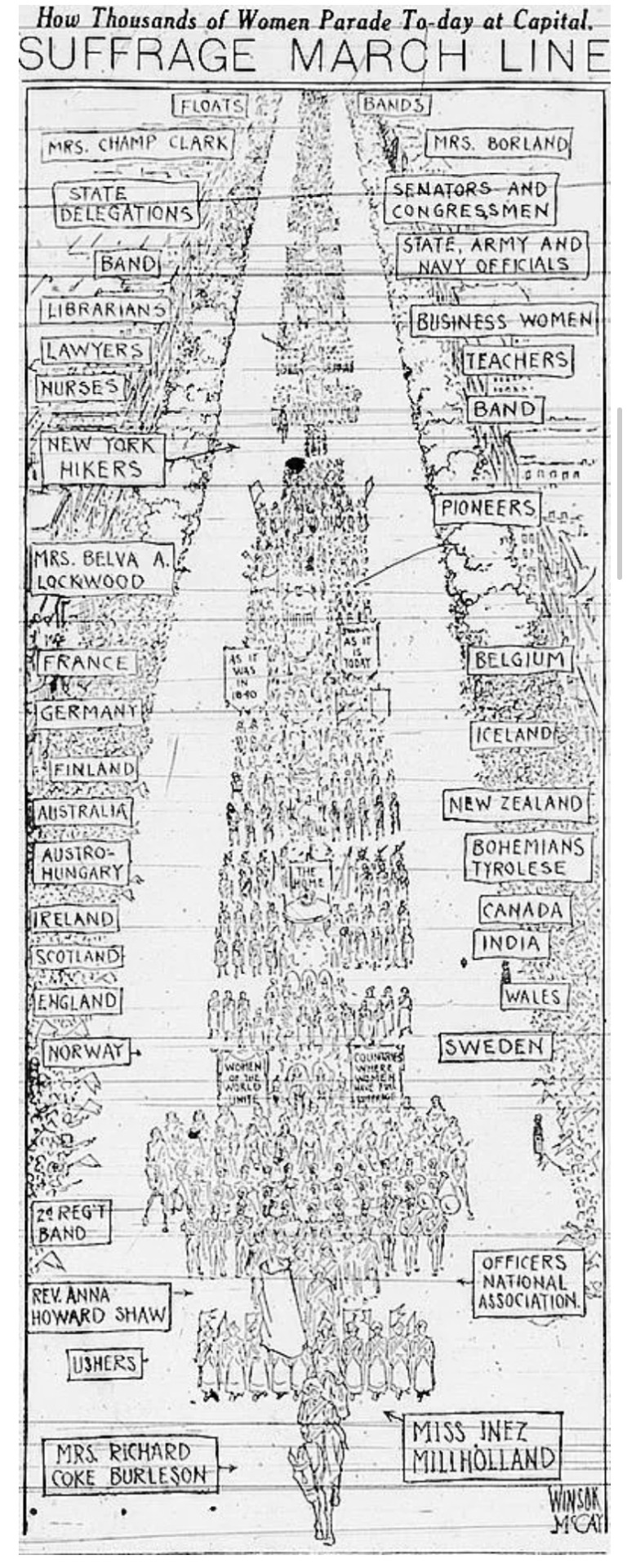
“
We march today to give evidence to the world of our determination, that this simple act of justice shall be done."
Woman Suffrage March program
The procession was designed present an argument, section by section, about the accomplishments of women in the nation and around the world. Women marched in delegations from their states, or with others from their professions, or in their academic regalia from the universities they attended. It demonstrated that women's participation in the public sphere was dignified and in keeping with America's moral values. Behind the marchers, bands played patriotic songs and elaborate floats illustrated the beauty and competence of women.
But very few of the spectators got to see the full demonstration as Paul had envisioned it. The crowd of at least 250,000 people did not stay on the sidewalk but began to stream into the streets and block the parade route. Police stationed along Pennsylvania Avenue were unable or unwilling to control the crowds. The marchers tried their best to continue. Those in cars or on horseback tried to drive the throng of people back and clear the street, but the crowd would simply fill back in behind them. Progress slowed and then stopped.
The marchers found themselves trapped in a sea of hostile, jeering men who yelled vile insults and sexual propositions at them. They were manhandled and spat upon. The women reported that they received no assistance from nearby police officers, who looked on bemusedly or admonished the women that they wouldn't be in this predicament if they had stayed home. Although a few women fled the terrifying scene, most were determined to continue. They locked arms and faced the ambush, some through tears. When they could, they ignored the taunts. Some brandished banner poles, flags, and hatpins to ward off attack. They held their ground until the U.S. Army troops arrived about an hour later to clear the street so that the procession could continue.
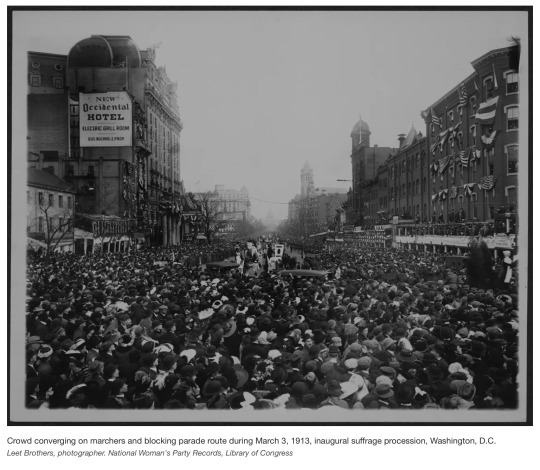
African American Women in the Procession
Black women felt like they were under attack long before the crowds descended upon the marchers. They had to fight just to be included in the procession. As described in the NAACP's newspaper:
“The women’s suffrage party had a hard time settling the status of Negroes in the Washington parade. At first, Negro callers were received coolly at headquarters. Then they were told to register, but found that the registry clerks were usually out. Finally, an order went out to segregate them in the parade, but telegrams and protests poured in and eventually the colored women marched according to their State and occupation without let or hindrance.” The Crisis, vol 5, no. 6, April 1913, page 267.
Ida B. Wells-Barnett traveled to Washington, D.C. with the Illinois delegation and fully expected to march with them. As the group was lining up to begin the procession, the white suffrage leaders suddenly asked Wells-Barnett not to march with her fellow suffragists from Illinois and instead assume a place in the back of the procession. Wells-Barnett refused and left the area. Instead, she waited along the side of Pennsylvania Avenue until the Illinois group marched by. Then she and two white allies stepped in front of the Illinois delegation and continued in the procession.
Although it is sometimes reported that African American women marched in the back of the procession, The Crisis reported that more than forty Black women processed in their state delegations or with their respective professions. Two were reported to have carried the lead banners for their sections. Twenty-five students from Delta Sigma Theta sorority from Howard University marched in cap and gown with the university women, as did six graduates of universities, including Mary Church Terrell.
"In spite of the apparent reluctance of the local suffrage committee to encourage the colored women to participate," reported The Crisis, "and in spite of the conflicting rumors that were circulated and which disheartened many of the colored women from taking part, they are to be congratulated that so many of them had the courage of their convictions and that they made such an admirable showing in the first great national parade.”

"Dawn Mist" and Native American Women
Before the 1913 Woman Suffrage Procession, newspapers announced that one of the marchers would be “Dawn Mist, the beautiful daughter of Chief Three Bears of the Glacier National ParkIndians.” The papers reported that Dawn Mist and her friends would ride their Indian ponies in their buckskin dresses in the parade, and camp on the National Mall in their teepees. They would “represent the wildest type of American womanhood” side by side with white women like Inez Milholland, who represented “the highest type of cultured womanhood.”
But Dawn Mist wasn’t a real person.
She was a character created by the public relations department of the Great Northern Railroad. The railroad hired Native American women to perform as Dawn Mist – at least three of them. They used images of the women posing as Dawn Mist in advertising and on postcards. In 1913, Daisy Norris, a Blackfoot woman, was working in the role of Dawn Mist for the Railroad. But she wasn’t in D.C. for the Suffrage Procession. It was all a publicity stunt.
There was, however, at least one native woman in the 1913 parade. Marie Louise Bottineau Baldwinmarched with the lawyers contingent in the procession. Of French and Ojibwe heritage, she was the first native woman to become a lawyer. She had moved to D.C. with her father to fight for tribal sovereignty and became a federal civil servant, working for the Federal Indian Bureau. She later advocated for Native American suffrage in her work with the Society for American Indians.
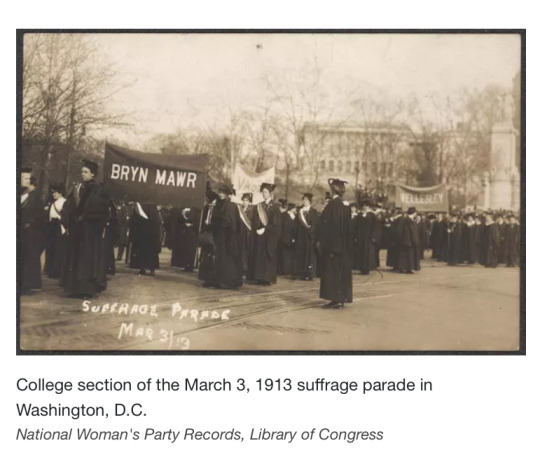
The Suffrage Movement Re-energized
The procession ended, a hour or so later than planned, with a dramatic tableau on the steps of the Treasury Building. The next day, headlines in newspapers around the country proclaimed the drama of the Woman Suffrage Procession. The coverage of the march was often more prominent on the front pages than news of Woodrow Wilson's inauguration. Congress began an investigation to determine why crowd control by the police had been so ineffective. The hearings kept the procession in the news even longer. Although the Washington, D.C demonstration was not the first suffrage march or the largest, the publicity it received brought new attention and energy to the movement, energy that would eventually push the 19th Amendment through Congress.
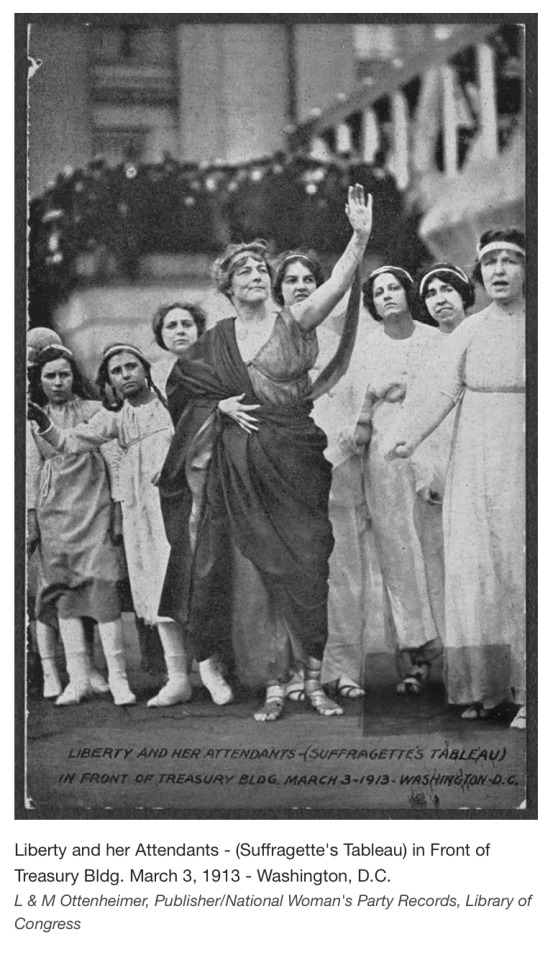
Sources:
Cahill, Cathleen. Recasting the Vote: How Women of Color Transformed the Suffrage Movement. UNC Press, 2020.
Rabinovitz-Fox, Einav. "New Women in Early Twentieth-Century America." Oxford Research Encyclopedias, August 2017.
Ware, Susan. Why They Marched: Untold STories of the Women Who Fought for the Right to Vote. Belknap/Harvard University Press, 2019.
Zahniser, J. D. and Amelia R. Fry. Alice Paul: Claiming Power. Oxford University Press, 2014.
#March 3 1913#National American Woman Suffrage Association (NAWSA)#Woman Suffrage Procession#The Great Demand
15 notes
·
View notes
Text
Nation Observes Veterans Day and Salutes the Troops
Nov. 10, 2021 | By David Vergun , DOD News
November 11 is Veterans Day, a federal holiday that is meant to honor all veterans of the uniformed services who served or are still serving during times of peace as well as war.
Veterans Day has its origins at the end of World War I when at the 11th hour of the 11th day of the 11th month of 1918, the fighting ended with the signing of an armistice. In 1919, President Woodrow Wilson proclaimed the first Armistice Day, Nov. 11. The day is also known as Remembrance Day in the Commonwealth of Nations. Wilson's proclamation stated:
"To us in America, the reflections of Armistice Day will be filled with solemn pride in the heroism of those who died in the country’s service and with gratitude for the victory, both because of the thing from which it has freed us and because of the opportunity it has given America to show her sympathy with peace and justice in the councils of the nations…"
Congress officially passed a concurrent resolution on June 4, 1926, with these words:
"Whereas the 11th of November 1918, marked the cessation of the most destructive, sanguinary, and far reaching war in human annals and the resumption by the people of the United States of peaceful relations with other nations, which we hope may never again be severed, and, whereas it is fitting that the recurring anniversary of this date should be commemorated with thanksgiving and prayer and exercises designed to perpetuate peace through good will and mutual understanding between nations …."
The resolution also encouraged the display of the U.S. flag on all government buildings and urged appropriate ceremonies.
A congressional act, approved May 13, 1938, made Nov. 11, a federal holiday.
In 1954, Congress — at the urging of veterans' organizations — changed the name to Veterans Day to honor service members who had served in all of the nation's wars.It should be pointed out that Veterans Day celebrates the service of all U.S. military veterans, while Memorial Day, a federal holiday on the last Monday in May, honors those who have died while in military service. Another military holiday that also occurs in May, Armed Forces Day, observed on the third Saturday in May, honors those currently serving in the U.S. military.
THANK YOU VETERANS!
16 notes
·
View notes